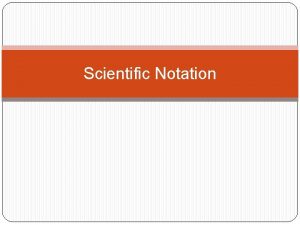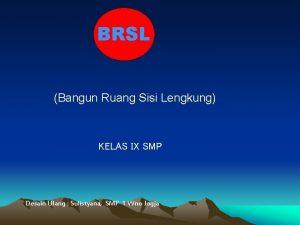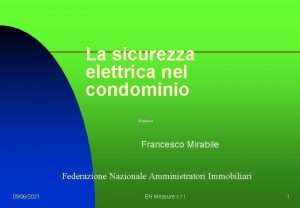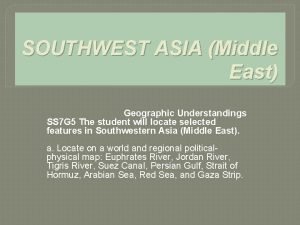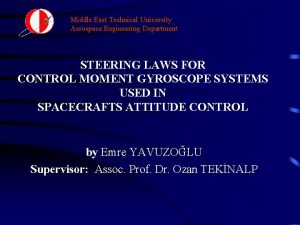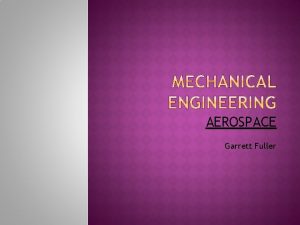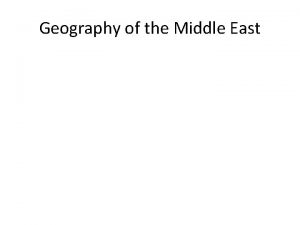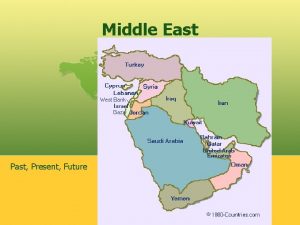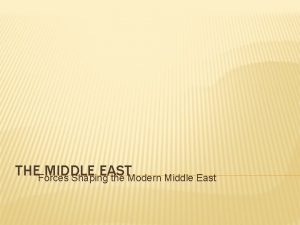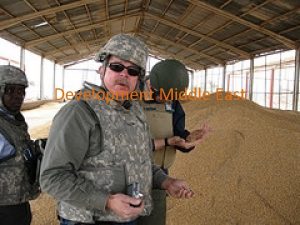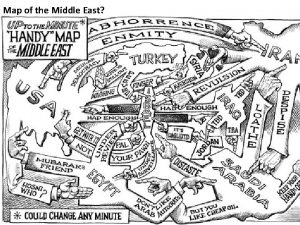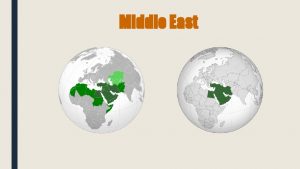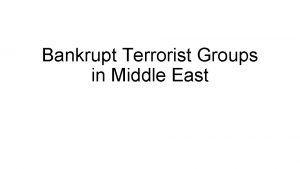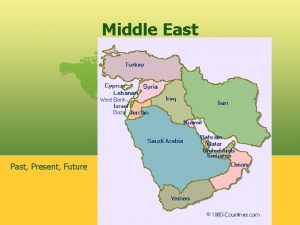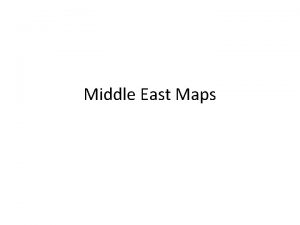MIDDLE EAST TECHNICAL UNIVERSITY AE 462 Aerospace Structures
























- Slides: 24


MIDDLE EAST TECHNICAL UNIVERSITY AE 462 – Aerospace Structures Design Minimum Weight Wing Design for a Utility Type Aircraft DESIGN TEAM : Osman Erdem ŞENOL Hasan YILMAZ

OUTLINE • • Design Objective Procedure Results Conclusion

Design Objective Design a suitable primary structure of least possible weight for the uniform cantilever wing of an utility type aircraft • Federal Aviation Regulations part 23 • An overall safety factor of 1. 5

Procedure • According to FAR 23 Appendix A with all the specified regulations the flight envelope for the aircraft is constructed. • For the Dive Speed and Minimum Maneuvering Speed points on the flight envelope spanwise Local lift coefficent and pitching moment coefficient variation is determined by the use of ESDU code 9510 v 12. • From the output of the code, internal load variaton along wing span is found tabulated and figured.

Procedure Sectional Shear Force Variaton at Minimum Maneuvering Speed Va 35000, 000 30000, 000 25000, 000 20000, 000 15000, 000 10000, 000 5000, 000 0, 0 50, 0 100, 0 150, 0 200, 0 250, 0 300, 0 350, 0 400, 0 450, 0 500, 0

Procedure Bending Moment Variation Along Wing Span at Maneuvering Speed Vd 70000, 000 60000, 000 50000, 000 40000, 000 30000, 000 20000, 000 10000, 000 0, 0 50, 0 100, 0 150, 0 200, 0 250, 0 300, 0 350, 0 400, 0 450, 0 500, 0

Procedure Pitching Moment Variation Along Wing Span at Minimum Maneuvering Speed Vd 0 0, 0 -500 -1000 -1500 -2000 -2500 -3000 -3500 -4000 -4500 -5000 50, 0 100, 0 150, 0 200, 0 250, 0 300, 0 350, 0 400, 0 450, 0 500, 0

Procedure With these calculated sectional loads wing structure is to be formed. The overall sizing of the internal wing structure is done through the principle of minimizing the margins of safety in order to achieve minimum weight design.

Procedure Material is Al 2024 • Widely used in aerospace structures. • Good strength characteristics comparing with low density. • Available in variable thicknesses of sheet.

Procedure MS Excel is used for the calculations. • Initial values for spar cap areas, web and skin thicknesses are assigned. • Main assumption on structural loading: – Shear forces are carried only by skins and webs – Axial loads are carried only by spar caps • Bending stresses are calculated from unsymetric bending formula. • Spar flange areas are resized in order to achieve positive margins of safety close to zero for axial stresses.

Procedure • Sectional shear flows are calculated with the help of defined intermediate variables and margins of safety for shear stresses are found. • In order to aproach margins of safety to zero, skin and web thickness values are edited. – Thickness values becomes very small for this requirement. Total weight was very low at the moment.

Procedure • After obtaining t and A values, shear center of the airfoil at different sections are calculated. • Additional torque due to the position of the shear center is calculated to be small, no further iterations are developed.

Procedure • Spar webs, skins and ribs are to be checked for shear buckling. • All the skins are considered as flat plates. – For this purpose leading edge is considered to have a stinger and the skin is divided into two straight lines. – Shear flow on this two plates are considered to be same as the curved plate.

Procedure • The airfoil is designed with 9 ribs for semi-span – The purpose for the selection of 9 ribs • As the buckling is considered to be more critical, by decreasing panel lengths, a/b ratios can be kept smaller especially for the leading edge skins and webs. As a result higher Ks and so higher critical buckling stresses. • Possibility to change flange areas and skin and web thicknesses for 10 different sections. • Ease of calculation. • Since there are 20 discrete sections for the internal loads for buckling stresses of 10 sections, the average loads are taken from the load data in between

Procedure

Procedure • The buckling margins of safety come out to be negative close to 1, that shows the thicknesses for the panels are required to be increased drastically. • The thicknesses are changed in order to have margins of safety close to 0 and positive.

Procedure • As the ribs have a very complex geometry it is difficult to model them for buckling • The rib is assumed to be a rectangular plate with b = front web and a = top panel • The shear stress acting on the wing ribs are the difference between the neighboor hood panels from both sides. • The average of the maximum shear flow couple is used for the buckling of the ribs. • Rib thicknesses are also determined for the minimum margins of safety.

Procedure Selection from the standard materials: • Throughout the iterations, skins, webs and rib thicknesses are edited as differences of at least 0. 1 mm. • Minimum spar cap area is set to be 1 cm 2. • From Table A 3. 15 of Bruhn Spar flange shape is selected as I beam model. It is available in different areas and dimensions.

Procedure • Now that all the margins of safety are larger than 0 considering all the fail modes, weight of the wing is to be calculated. • Wing Structure consists of – Spar Caps: 4 discrete each section for 10 sections – Skins: top, front and bottom of 10 discrete sections – Spar Webs: front and rear spar 10 discrete sections – Ribs: a total of 9 between every section.

Results Same procedure from the start is applied for both the load cases, point A and D. – The design weight for point A = 81. 136 – The design weight for point D = 85. 502 kg Thus Point D, dive speed loading case is more critical.

Results All the wing elements’ dimensions are tabulated in the design report for each section. The general trend for all dimensions are as expected; larger at wing root and becoming smaller as advanced to wing tip.

Conclusion • • What is achieved: How to construct a filght envelope is learned. Difference in flight loading at different flight conditions are seen. The effects of the wing structural elements’ dimensions on different failure modes are observed. The importance of design for buckling type of failure become evident.

Thank you for listening Questions?
 Kalahari desert on africa map
Kalahari desert on africa map Ocw
Ocw Rockwell collins technical publications
Rockwell collins technical publications Winds that blow over short distances are called
Winds that blow over short distances are called East is east and west is west
East is east and west is west 462 na in scientific notation
462 na in scientific notation Ie 462
Ie 462 Any size
Any size Volume sebuah kaleng berbentuk tabung adalah 6160 cm
Volume sebuah kaleng berbentuk tabung adalah 6160 cm Lied 769 eens als de bazuinen klinken
Lied 769 eens als de bazuinen klinken 462 na in scientific notation
462 na in scientific notation Nodo equipotenziale
Nodo equipotenziale Find the odd one : 396, 462, 572, 427, 671, 264
Find the odd one : 396, 462, 572, 427, 671, 264 Ie 462
Ie 462 Ie 462
Ie 462 Ie 462
Ie 462 Ie 462
Ie 462 Ie 462
Ie 462 Opwekking 462
Opwekking 462 Homologous structures
Homologous structures Middle east natural resources
Middle east natural resources Ethnic groups in the middle east
Ethnic groups in the middle east Why is it called middle east
Why is it called middle east Physical features in the middle east
Physical features in the middle east Why is the middle east so dry
Why is the middle east so dry





